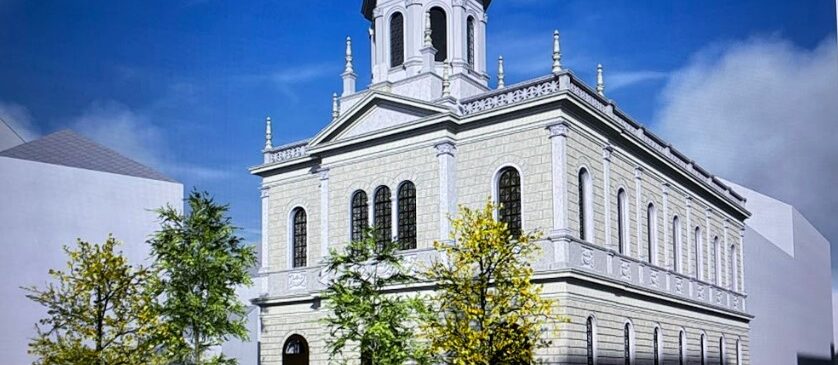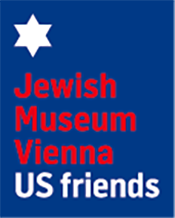Out and about in “Our City!” – Rudolfsheim-Fünfhaus
Jan 5, 2021 | JMW News

Do you know where Fünfhaus lies and where Sechshaus is located? A Kiddush cup from the Fünfhauser Temple and plaques for charitable institutions from the synagogue in Sechshaus can be found at the Jewish Museum Vienna. Both houses of worship had their addresses in today’s 15th district. In the 18th and early 19th centuries, the site next to the unregulated Vienna River encouraged the settlement of craftsmen and manufacturers such as dye works who needed water for their businesses. The huge area of the Schmelz was used as a parade ground from 1847 and was not populated until the beginning of the 20th century. The suburbs were incorporated into the City of Vienna on January 1, 1892.
Sechshaus is the southernmost part of Vienna’s 15th district, Fünfhaus its northern and eastern part. Since 1957, the district has been called Rudolfsheim-Fünfhaus and is one of the 89 Viennese cadastral communities. Emperor Franz I’s Land Tax Act of December 23, 1817 established the basis for this. The spatial administrative unit summarized in the land register was used to assess property tax.
In the perception of many Viennese, the suburbs or the districts outside the Gürtel Belt Road are not very linked or not connected at all to Jewish history. The number of objects salvaged from the synagogues in these districts before the November Pogrom is relatively small. Therefore, it is worth taking a closer look.

Image © JMW
According to the dedication inscription, it can be determined that this object is a donation for the Fünfhauser Temple, which Wolf Friedmann and his wife Zippora presented as honorable members of this community in 1852. Back then, Fünfhaus was still a suburb and the so-called “Turnertempel” at Turnergasse 22 had not yet been built. A Kiddush cup is filled with wine and is used to greet the holiday with a blessing that is recited over the wine. In addition to an old Viennese hallmark for the year 1852 and an illegible master’s mark, the inventory number 88 can be made out in the metal. The Jewish Museum received this object from the Max Berger Collection, which was made available to the City of Vienna in 1986 for the re-establishment of the Jewish Museum. Just how Max Berger came into possession of this object can no longer be retraced. Museums are subject to restitution, so the Kiddush cup was researched and recommended by the Restitution Commission for restitution to the Jewish Community of Vienna, which is the legal successor to the synagogues dissolved or destroyed in 1938. 12.5 centimeters high and weighing 162 grams, the rather light cup tells Viennese Jewish history in a multidimensional way.

Image © JMW
At Turnergasse 22 in Fünfhaus, the so-called “Turnertempel” was planned and built by Carl König in 1872. The illustration shows a close-up of the east side of the synagogue. The “bema,” the lectern from which the Torah is read, is easily distinguishable. In 1888, Carl König designed another synagogue in the Bohemian town of Liberec (Reichenberg), the Agricultural Products Exchange building on Taborstraße, the House of Industry on Schwarzenbergplatz and many other commercial and residential structures in Vienna.

Image © JMW
Founded in 1896, the prayer house association “Emunas Awes” (“Faith of the Fathers”) was located at Storchengasse 21 and housed a school that was converted into a synagogue in 1930. Ignaz Reiser drew up the plans for this. No historical photographs or other images of this house of prayer exist. The blueprints used by the students of the Vienna University of Technology for the digital reconstruction of the Viennese and Austrian synagogues that were destroyed in 1938 have been preserved. www.lichtzeichen.wien provides a good insight into this project. Visitors can experience these reconstructions on a screen in the Visual Storage of the Jewish Museum Vienna on Dorotheergasse. Not only can they take a walk through Vienna, but travel all over Austria. The architect Ignaz Reiser studied under Carl König and was also responsible for the synagogue on Pazmanitengasse in Vienna-Leopoldstadt, the Winter Prayer Room of the synagogue on Hubergasse in Vienna-Ottakring, as well as the ceremonial hall and administration building for the Jewish section of Vienna’s Central Cemetery. Reiser also designed the synagogue and office building of the Jewish Community of Mödling.

Image © JMW
As part of the Jewish Community of Vienna collection, these well-preserved plaques were permanently loaned to the Jewish Museum Vienna in 1992. Made around 1880, they are 11 x 6 cm in size. The inscriptions provide information about the many opportunities for charity in this synagogue. Perhaps the plaques were attached to donation cans – for a women’s charity, for the Chevra Kadisha (burial brotherhood), for a support association “Maskil El Dol” and an institution of former board members of the Jewish Community of Vienna. The dating of these plaques points back to the time the school was converted into a synagogue in 1930.

Image © Ouriel Morgensztern
The Viennese artist Arik Brauer, born as Erich Brauer in Vienna in 1929, was sent to the Turnertempel to audition. In an interview with director Danielle Spera in the magazine NU, the artist ironically said that the Nazi seizure of power had ended his career as a cantor before it even started. It is well known that Arik Brauer made a musical career despite or precisely because of this fact.

Image © JMW
It is not known whether the cartoonist Paul Peter Porges could also sing. His family ran a grocery store on Moeringgasse in Rudolfsheim-Fünfhaus. Born in 1927, Paul Peter was able to leave Vienna for France on a Kindertransport. On the way from home to the Westbahnhof, where the train to freedom that would ultimately save him departed, his family, accompanying him to the station, passed by the Märzpark. As a Jewish child, Paul Peter Porges was not allowed to go in there, but his father thought that his son should do it one last time before leaving. However, young Paul Peter did not dare. The red pullover was a present from grandmother Gigi when he left for France; the three Ps stand for Paul Peter Porges. The nickname, already in use in Vienna, accompanied him to France, through Switzerland and on to New York, where he became a well-known cartoonist and PPP became his moniker.
Get a closer look at the pullover here
Speaking of Westbahnhof: Located in the immediate vicinity of the train station at Mariahilferstraße 135 and the corner of Palmgasse was Café Palmhof, which Otto Pollak ran with his brother Karl from 1919 to 1938. The exhibition “Let’s Dance. The Viennese Cafetier Otto Pollak” offered an interesting insight into a true “hotspot” of the Viennese coffee house and event scene and impressively demonstrated that no one should underestimate the suburbs. They served raspberry soda there! And even held a Miss Vienna contest…You can find out more about Café Palmhof on YouTube.
Cover image © JMW
